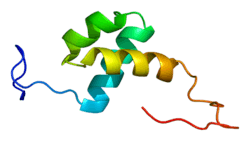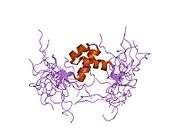LCOR
Ligand-dependent corepressor is a protein that in humans is encoded by the LCOR gene.[3][4][5]
Function
LCOR is a transcriptional corepressor widely expressed in fetal and adult tissues that is recruited to agonist-bound nuclear receptors through a single LxxLL motif, also referred to as a nuclear receptor (NR) box.[5]
References
- 1 2 3 GRCh38: Ensembl release 89: ENSG00000196233 - Ensembl, May 2017
- ↑ "Human PubMed Reference:".
- ↑ Fernandes I, Bastien Y, Wai T, Nygard K, Lin R, Cormier O, Lee HS, Eng F, Bertos NR, Pelletier N, Mader S, Han VK, Yang XJ, White JH (Jan 2003). "Ligand-dependent nuclear receptor corepressor LCoR functions by histone deacetylase-dependent and -independent mechanisms". Mol Cell. 11 (1): 139–50. doi:10.1016/S1097-2765(03)00014-5. PMID 12535528.
- ↑ White JH, Fernandes I, Mader S, Yang XJ (Jun 2004). "Corepressor recruitment by agonist-bound nuclear receptors". Vitam Horm. 68: 123–43. doi:10.1016/S0083-6729(04)68004-6. PMID 15193453.
- 1 2 "Entrez Gene: LCOR ligand dependent nuclear receptor corepressor".
Further reading
- Nagase T, Nakayama M, Nakajima D, et al. (2001). "Prediction of the coding sequences of unidentified human genes. XX. The complete sequences of 100 new cDNA clones from brain which code for large proteins in vitro". DNA Res. 8 (2): 85–95. doi:10.1093/dnares/8.2.85. PMID 11347906.
- Strausberg RL, Feingold EA, Grouse LH, et al. (2003). "Generation and initial analysis of more than 15,000 full-length human and mouse cDNA sequences". Proc. Natl. Acad. Sci. U.S.A. 99 (26): 16899–903. doi:10.1073/pnas.242603899. PMC 139241. PMID 12477932.
- Kunieda T, Park JM, Takeuchi H, Kubo T (2003). "Identification and characterization of Mlr1,2: two mouse homologues of Mblk-1, a transcription factor from the honeybee brain(1)". FEBS Lett. 535 (1–3): 61–5. doi:10.1016/S0014-5793(02)03858-9. PMID 12560079.
- Shi Y, Sawada J, Sui G, et al. (2003). "Coordinated histone modifications mediated by a CtBP co-repressor complex". Nature. 422 (6933): 735–8. doi:10.1038/nature01550. PMID 12700765.
- Ota T, Suzuki Y, Nishikawa T, et al. (2004). "Complete sequencing and characterization of 21,243 full-length human cDNAs". Nat. Genet. 36 (1): 40–5. doi:10.1038/ng1285. PMID 14702039.
- Deloukas P, Earthrowl ME, Grafham DV, et al. (2004). "The DNA sequence and comparative analysis of human chromosome 10". Nature. 429 (6990): 375–81. doi:10.1038/nature02462. PMID 15164054.
- Gerhard DS, Wagner L, Feingold EA, et al. (2004). "The status, quality, and expansion of the NIH full-length cDNA project: the Mammalian Gene Collection (MGC)". Genome Res. 14 (10B): 2121–7. doi:10.1101/gr.2596504. PMC 528928. PMID 15489334.
This article is issued from
Wikipedia.
The text is licensed under Creative Commons - Attribution - Sharealike.
Additional terms may apply for the media files.



